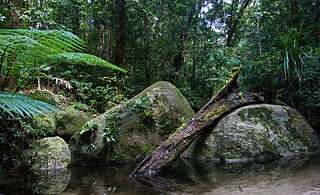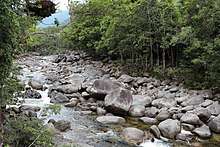Daintree National Park
The Daintree rainforest is a national park in Far North Queensland, Australia, 1,757 km (1,092 mi) northwest of Brisbane and 100 km (62 mi) northwest of Cairns. It was founded in 1981[1] and is part of the Wet Tropics of Queensland. In 1988 it became a World Heritage Site.[1][2][3] The park consists of two sections, with a settled agricultural area between them which includes the towns of Mossman and Daintree Village.
| Daintree National Park Queensland | |
|---|---|
IUCN category II (national park) | |
 A typical rainforest scene in Daintree National Park | |
 Daintree National Park | |
| Nearest town or city | Daintree |
| Coordinates | 15°57′33″S 145°24′07″E |
| Established | 1988 |
| Area | 1,200 km2 (463.3 sq mi) |
| Managing authorities | Queensland Parks and Wildlife Service |
| Website | Daintree National Park |
| See also | Protected areas of Queensland |
One entrance to Daintree National Park is located south of the Daintree River at Mossman Gorge where a visitor centre has been built from where tourists take a shuttle bus to the gorge, where they can take a walk or a refreshing swim.
The most spectacular and oldest part of the Daintree rain forest is north of the Daintree River. After crossing the river on an old fashioned cable ferry there is a range of boardwalks and untouched beaches to explore, and the endangered cassowary can be encountered anywhere.
Daintree National Park is valued because of its exceptional biodiversity.[4] It contains significant habitat for rare species and prolific birdlife. The name is derived from the Daintree River, which was named by George Elphinstone Dalrymple, an early explorer of the area, after his friend Richard Daintree.
Mossman Gorge section

The Great Dividing Range is close to the coast in this region. This section covers 56,500 ha of mostly inaccessible rainforests and mountain woodlands.[4] The popular Mossman Gorge is located in the southern part of the park.[2] Located 75 km north of Cairns via the Captain Cook Highway and Mossman, the gorge offers many scenic exploration walks including Baral Marrjanga, Lower river track, Rex Creek bridge, and the Rainforest circuit track. It is inhabited by incredible flora and fauna including Boyd’s forest dragon and Victoria’s riflebird.[5]
Cape Tribulation section
Cape Tribulation also lies in the park.[2] Originally the cape belonged to Cape Tribulation National Park from 1981 but was amalgamated into Daintree National Park in 1983.[4] This section covers 17,000 ha including the coastal range (Thornton's Peak, Mt Hemmant, and Mt Sorrow, going north from the Daintree river) and contains Australia's last extensive stands of lowland rainforest.[4] It has extensive (and relatively) unspoiled beaches from Thornton beach to Cape Tribulation beach – fringed with the increasingly rare littoral (beachside) rainforest. The Daintree river is the southern boundary for the region - reinforced by the need to take a cable ferry across the Daintree river. Much of the coastal flatlands, especially to the south of the Alexandra range, and in Cow Bay, were cleared for agriculture in the late 1800s with a major clearing push in the 1970s. A lot of this has since recovered or has been settled.
The Daintree National Park's traditional owners are the Eastern Kuku Yalanji Aboriginal people. Many of the natural features of the landscape hold spiritual significance for the traditional owners.[6] One of these features is the location of the bouncing stones at Thornton Beach. The rocks here are hornfels, metamorphic rocks resulting from the effects of a major intrusion of granite that produced the coastal mountains.[1] They are very elastic, when bounced on the local rock pavement; The park contains the Mossman River to the south, the Daintree River and the Bloomfield River to the north.
Flora
Much of the national park is covered by tropical rainforest.[4] The Greater Daintree Rainforest has existed continuously for more than 110 million years, making it possibly the oldest existing rainforest. The persistence of this rainforest is believed to be a product of a fortuitous continental drift; after the breakup of its parent supercontinent a portion drifted toward the pole to become Antarctica, disturbing ocean currents and becoming quite chilly, while other portions were moved to hotter and drier locations. The rainforests of the parent continent preserved its climate, and so also its original trees. Tree species, once thought to be long extinct, have only relatively recently been discovered here.
Fauna
.jpg)
The park supports more than 430 bird species. The wompoo fruit-dove is one of six species of pigeon that live in the park[1][2] as well as significant populations of the endangered cassowary, a flightless bird of substantial size. The buff-breasted paradise kingfisher is a seasonal visitor. Mammals include the striped possum, Daintree River ringtail possum, brown bandicoot, long-nosed bandicoot, musky rat-kangaroo, Bennett’s tree kangaroo, swamp wallaby, platypus and short-beaked echidna. At least 23 species of reptile and 13 species of amphibian can be found in the park.[7][8][9] Among the reptiles present are Boyd's forest dragon, eastern water dragon, chameleon gecko, northern leaf-tailed gecko, the scrub or amethystine python, keelback, and the green and northern tree snakes. Frogs found in the park include the Australian lacelid, white-lipped treefrog, colourful-eyed treefrog and common mist frog. The introduced cane toad is also present in the park.
See also
References
- Reid, Greg (2004). Australia's National and Marine Parks: Queensland. South Yarra, Victoria: Macmillan Education Australia. p. 21. ISBN 0-7329-9053-X.
- Hema Maps (1997). Discover Australia's National Parks. Milsons Point, New South Wales: Random House Australia. p. 168. ISBN 1-875992-47-2.
- Mounter, Brendan; Staley, Phil (25 December 2018). "Wet Tropics — how Queensland's Daintree rainforest was saved". ABC Far North. Australian Broadcasting Corporation. Retrieved 27 December 2018.
- Explore Queensland's National Parks. Prahran, Victoria: Explore Australia Publishing. 2008. pp. 10–13. ISBN 978-1-74117-245-4.
- "Daintree National Park" (PDF). Queensland Government Parks And Forests.
- "Daintree National Park". Department of National Parks, Recreation, Sport and Racing. Retrieved 13 June 2013.
- Torr, Geordie (1993). "A survey of the reptiles and amphibians of the Mossman Gorge section of the Daintree National Park, Queensland". Australian herpetology: a diverse discipline: 75–79.
- Torr, Geordie (1996). "Further additions to the herpetofauna of the Mossman Gorge section of Daintree National Park, Queensland". Herpetofauna. 26: 49.
- Torr, Geordie (1998). "A low elevation record for the Rainforest gecko Carphodactylus laevis and a further addition to the herpetofauna of the Mossman Gorge section of Daintree National Park, Qld". Herpetofauna. 28: 53.
External links
![]()